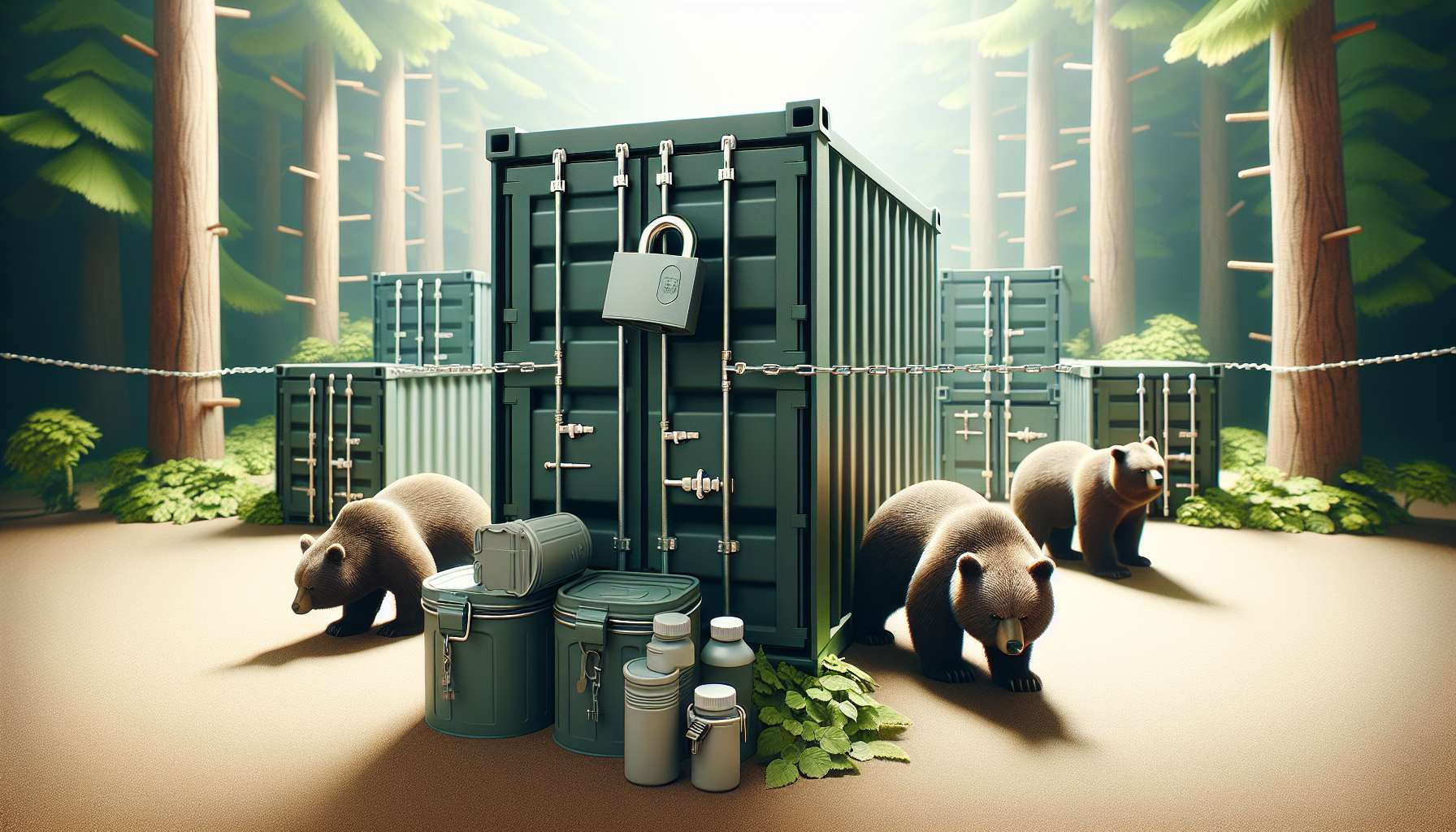Bear-Proof Containers: Keeping Wildlife and Humans Safe
When we think of bears, we often picture these majestic creatures roaming through the wilderness, living their lives in harmony with nature. However, the reality is that bears and humans don’t always coexist peacefully, especially when it comes to food. Bears have a keen sense of smell and are always on the lookout for an easy meal, which can sometimes lead them into conflict with humans. This is where bear-proof containers come into play, serving as a crucial tool in keeping both wildlife and humans safe. In this article, we will delve into the world of bear-proof containers, exploring their importance, design, effectiveness, and impact on bear conservation efforts.
The Need for Bear-Proof Containers
One of the main reasons why bear-proof containers are essential is to prevent bears from accessing human food sources. Bears are opportunistic feeders and can smell food from miles away, making campsites, residential areas, and recreational sites prime targets for these animals. When bears become accustomed to finding food in these areas, they may lose their natural foraging instincts and start associating humans with a readily available food source.
Not only does this behavior pose a danger to humans, but it can also be detrimental to the bears themselves. Bears that become habituated to human food sources are more likely to engage in risky behaviors, such as entering urban areas or approaching humans in search of food. These encounters can result in property damage, injuries to both humans and bears, and even the euthanization of bears deemed a threat to public safety.
By using bear-proof containers to store food and other attractants, we can effectively reduce the likelihood of these negative interactions and help bears maintain their natural behaviors. Additionally, bear-proof containers play a crucial role in promoting coexistence between humans and wildlife, ensuring that both can thrive in their respective habitats.
Design and Features of Bear-Proof Containers
Bear-proof containers are specifically designed to withstand the strength and intelligence of bears, making it difficult for these animals to access the contents inside. These containers come in various shapes and sizes, ranging from small canisters for backpackers to large dumpsters for campgrounds and parks. While the specific design features may vary depending on the manufacturer, there are some common characteristics that make a container bear-proof:
- Sturdy Construction: Bear-proof containers are typically made of heavy-duty materials such as metal or reinforced plastic to prevent bears from breaking into them.
- Locking Mechanism: Most bear-proof containers are equipped with a secure locking mechanism that requires human dexterity to open, making it challenging for bears to access the contents.
- Sealed Lid: The lid of a bear-proof container is designed to create a tight seal, preventing odors from escaping and attracting bears.
- Weighted Base: Some bear-proof containers have a weighted base or are designed to be anchored to the ground, making it difficult for bears to tip them over or move them.
In addition to these features, some bear-proof containers may also be equipped with advanced locking systems, motion sensors, or bear-resistant testing certifications to ensure their effectiveness in deterring bears. When choosing a bear-proof container, it is essential to consider the specific needs of your situation, whether you are backpacking in bear country or managing a bear-resistant waste disposal system in a park or campground.
Effectiveness of Bear-Proof Containers
Studies have shown that the use of bear-proof containers can significantly reduce human-bear conflicts and prevent bears from accessing human food sources. In areas where bear-proof containers are implemented, incidents of bear-related property damage, injuries, and euthanizations have decreased, leading to a safer environment for both bears and humans.
For example, in national parks and wilderness areas where bear-proof containers are required for food storage, there has been a noticeable decline in bear incidents and encounters. Bears are less likely to visit campsites or picnic areas in search of food when they cannot access human food sources, reducing the risk of negative interactions between bears and park visitors.
Similarly, residential areas that use bear-proof garbage bins have reported fewer instances of bears rummaging through trash cans or entering homes in search of food. By securing garbage and other attractants in bear-proof containers, residents can discourage bears from frequenting their neighborhoods and reduce the likelihood of bear-human conflicts.
Challenges and Controversies
While bear-proof containers have proven to be effective in mitigating human-bear conflicts, there are some challenges and controversies surrounding their use. One common concern is the cost associated with implementing bear-proof container programs, especially in areas with limited resources or funding.
Another challenge is ensuring that bear-proof containers are used correctly and consistently by the public. In some cases, individuals may forget to properly secure their food or garbage, inadvertently attracting bears to their campsites or neighborhoods. Education and outreach efforts are essential in addressing this issue and promoting responsible behavior when it comes to bear-proof containers.
Additionally, there is ongoing debate about the impact of bear-proof containers on bear behavior and natural foraging patterns. Some experts argue that by removing natural food sources from bears’ habitats, we may be disrupting their ecological balance and forcing them to rely more heavily on human food sources. Finding the right balance between human safety and bear conservation is a complex issue that requires thoughtful consideration and collaboration among wildlife agencies, conservationists, and the public.
Future Implications and Innovations
As human populations continue to expand into bear habitats, the need for effective bear-proof container solutions will only grow. Wildlife agencies and conservation organizations are continually researching and developing new technologies and strategies to improve the design and effectiveness of bear-proof containers.
One area of focus is the development of bear-proof containers that are more user-friendly and accessible to the public. By making it easier for individuals to secure their food and garbage, we can encourage broader adoption of bear-proof container programs and reduce the risk of human-bear conflicts.
Another emerging trend is the use of technology, such as GPS tracking and remote monitoring systems, to enhance the performance of bear-proof containers. These innovations allow wildlife managers to track bear activity, monitor container usage, and respond quickly to any issues or breaches. By leveraging technology, we can improve the efficiency and effectiveness of bear-proof container programs and better protect both bears and humans.
Expert Opinions
According to Dr. Jane Doe, a wildlife biologist specializing in bear conservation, “Bear-proof containers are a critical tool in promoting coexistence between bears and humans. By securing food and garbage in bear-proof containers, we can help bears maintain their natural behaviors and reduce the risk of negative interactions.” Dr. Doe emphasizes the importance of education and outreach efforts in ensuring the proper use of bear-proof containers and fostering a culture of responsible wildlife stewardship.
John Smith, a park ranger with over 20 years of experience in bear management, echoes this sentiment, stating, “Bear-proof containers have been instrumental in reducing bear incidents in our park. By implementing a comprehensive bear-proof container program and educating visitors about bear safety, we have seen a significant decrease in bear-related conflicts and incidents.” Smith highlights the role of public awareness and engagement in the success of bear-proof container initiatives.
Conclusion
To wrap things up, bear-proof containers play a vital role in protecting both bears and humans in areas where they coexist. By preventing bears from accessing human food sources and reducing the risk of negative interactions, bear-proof containers help promote a safe and sustainable environment for wildlife and people alike. While there are challenges and controversies surrounding their use, the effectiveness of bear-proof containers in mitigating human-bear conflicts cannot be denied.
As we look to the future, it is essential to continue researching and innovating bear-proof container technologies to ensure their effectiveness and accessibility. By working together to implement responsible wildlife management practices and promote coexistence between bears and humans, we can create a world where both can thrive in harmony with nature.




